The Ancient of Days
The Ancient of Days is a design by William Blake, originally published as the frontispiece to the 1794 work Europe a Prophecy. It draws its name from one of God's titles in the Book of Daniel and shows Urizen[1] crouching in a circular design with a cloud-like background. His outstretched hand holds a compass over the darker void below. Related imagery appears in Blake's Newton, completed the next year. As noted in Alexander Gilchrist's 1863 book, Life of William Blake, the design of The Ancient of Days was "a singular favourite with Blake and as one it was always a happiness to him to copy."[2] As such there are many versions of the work extant, including one completed for Frederick Tatham only weeks before Blake's death.[2]
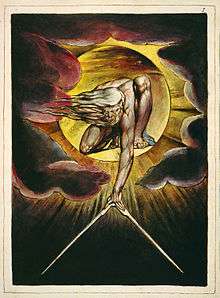
The British Museum notes that one copy, accessioned in 1885, was excluded from Martin Butlin's 1982 catalogue raisonné of Blake's paintings and drawings, suggesting the author doubted that attribution.[3]
Early critics of Blake noted the work as amongst his best, and a favourite of the artist himself. A description by Richard Thompson in John Thomas Smith's Nollekens and His Times, was of "... an uncommonly fine specimen of art, and approaches almost to the sublimity of Raffaelle or Michel Angelo." and as representing the event given in the Book of Proverbs viii. 27 (KJV), "when he set a compass upon the face of the earth."[4] The subject is said to have been one of the 'visions' experienced by Blake and that he took an especial pleasure in producing the prints. The copy commissioned by Tatham in the last days of Blake's life, for a sum of money exceeding any previous payment for his work, was tinted by the artist while propped up in his bed. After his revisions, Blake is said to have,[4]
threw it from him, and with an air of exulting triumph exclaimed, "There, that will do! I cannot mend it."
The image was used as the 2006 paperback cover of Stephen Hawking's 2005 book God Created the Integers.
Also used as design influence for The Concept album cover by American funk band Slave, 1978.
Gallery of extant copies
There are currently thirteen known extant copies of Europe a Prophecy. Because of Blake's production process of hand colouring each print, each image has its own unique qualities. The following images of The Ancient of Days are those available via the digital archiving project, the William Blake Archive:[5]
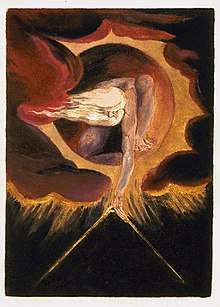 The Ancient of Days in Europe a Prophecy copy B from the Glasgow University Library
The Ancient of Days in Europe a Prophecy copy B from the Glasgow University Library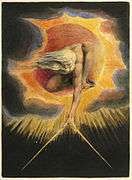 The Ancient of Days in Europe a Prophecy copy D from the British Museum
The Ancient of Days in Europe a Prophecy copy D from the British Museum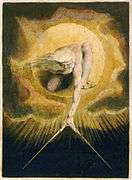 The Ancient of Days in Europe a Prophecy copy E from the Library of Congress
The Ancient of Days in Europe a Prophecy copy E from the Library of Congress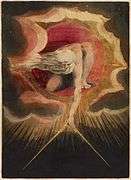 The G copy, Morgan Library & Museum[6]
The G copy, Morgan Library & Museum[6]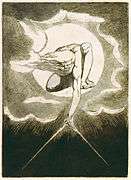 The Ancient of Days in Europe a Prophecy copy H from the Houghton Library
The Ancient of Days in Europe a Prophecy copy H from the Houghton Library The Ancient of Days in Europe a Prophecy copy K from the Fitzwilliam Museum
The Ancient of Days in Europe a Prophecy copy K from the Fitzwilliam Museum
References
- Kaiser, Christopher B. (1997). Creational Theology and the History of Physical Science: The Creationist Tradition from Basil to Bohr. Studies in the History of Christian Thought. 78. Brill Publishers. p. 329. ISBN 9789004106697.
Urizen, best known from the colour print 'The Ancient of Days'
- Gilchrist (1863). pp. 379-380
- "Object details". Catalogue search. London: British Museum. Retrieved 1 March 2010.
- Smith, John Thomas (1829). ""Blake"". Nollekens and his times. 2. London: Henry Colburn. pp. 473, 485 & footnote.
- "Europe a Prophecy". The William Blake Archive. Retrieved 16 May 2013.
- Morgan Library page
External links
![]()